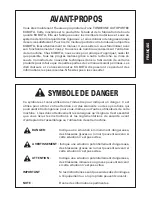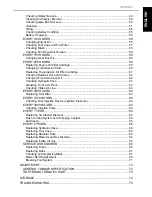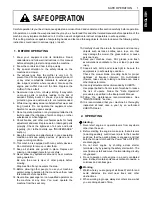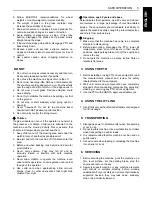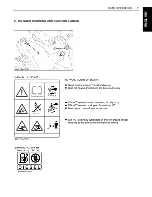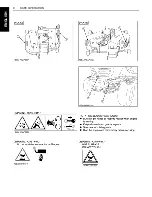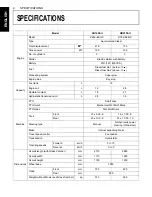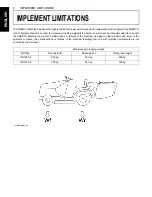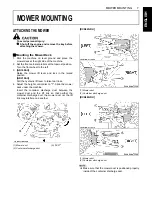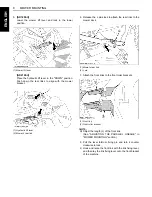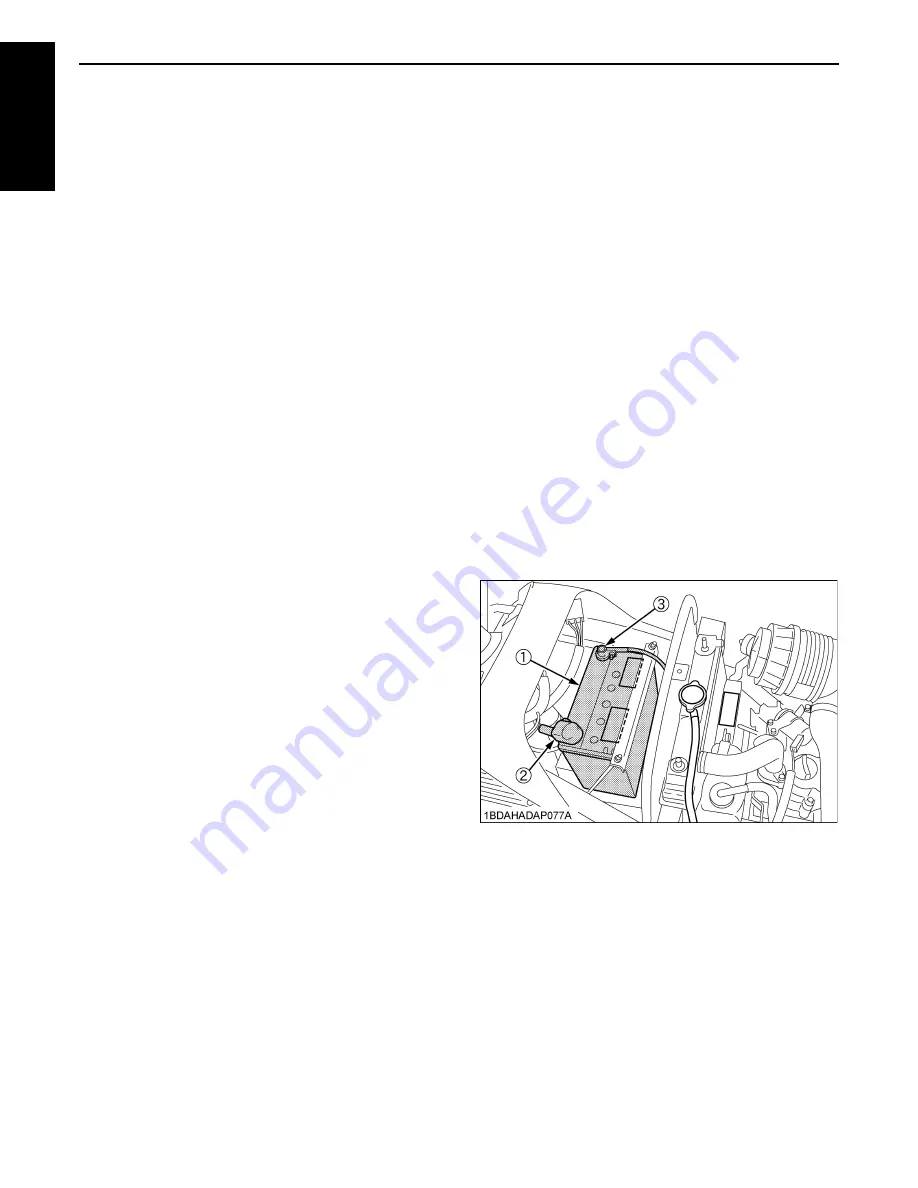
SAFE OPERATION
4
ENGLISH
3. To avoid injury, do not adjust, unclog or service the
mower or grass catcher with the engine running. Make
sure rotating blades are stopped before dismounting
the riding mower.
4. Disengage power to attachment(s), stop the engine
and remove the key before making any repairs or
adjustments.
5. Allow the machine to cool off before servicing the
engine, muffler, etc.
6. Keep your riding mower clean. Dirt and grass build-up
can cause fires and may lead to serious personal
injury.
Periodically wash the grass container to insure the
safety signs can be read.
Replace all safety signs that are damaged, lost or have
otherwise become illegible. If a part to be replaced has
a sign on it, obtain a new safety sign from your
KUBOTA Dealer and install it in the same place as on
the removed part.
7. Use extra care in handling diesel fuels. They are
flammable.
(1) Use only an approved container.
(2) Do not remove fuel cap or refuel with the engine
running. Allow engine to cool before refueling. Do
not smoke while refueling or when standing near
fuel.
(3) Do not refuel the machine indoors and always
clean up spilled fuel or oil.
(4) Do not store the machine or fuel container inside
where there is an open flame, such as in a water
heater.
(5) If the fuel tank has to be drained, this should be
done outdoors.
(6) Replace all fuel tanks and container caps
securely
8. Do not change the engine governor setting or
overspeed the engine. Operating the engine at
excessive speed can increase the hazard of personal
injury.
9. Never run a machine inside a closed area.
10.Mower blades are sharp and can cut your hands. Wrap
the blade(s) or wear gloves, and use extra caution
when servicing them.
11.Keep nuts and bolts, especially blade attachment
bolts, tight and keep equipment in good condition. On
multi-bladed mowers, take care as rotating one blade
can cause other blades to rotate.
12.Do not smoke when working around the battery.
Keep all sparks and flames away from battery. The
battery presents an explosion hazard because it gives
off hydrogen and oxygen...especially when
recharging.
13. Before "JUMP STARTING" a dead battery, read and
follow all of the instructions to help protect the
alternator from damage due to extreme load changes.
(See "JUMP STARTING" in "OPERATING THE
ENGINE" section.)
Batteries contain sulfuric acid and produce explosive
gases. Follow the instructions below to prevent
personal injury.
A
Wear eye and skin protection.
A
Keep sparks and flame away.
A
Always have adequate ventilation while charging
or using the battery.
14. Keep first aid kit and fire extinguisher available at all
times.
15. Disconnect the battery's negative (-) cable before
working on or near electric components.
16. Do not use or charge the refillable type battery if the
fluid level is below the LOWER (lower limit level) mark.
Otherwise, the battery component parts may
prematurely deteriorate, which may shorten the
battery's service life or cause an explosion. Check the
fluid level regularly and add distilled water as required
so that the fluid level is between the UPPER and
LOWER levels.
17. To avoid sparks from an accidental short circuit,
always disconnect the battery's negative (-) cable first
and connect it last.
18. Make sure cir-clips, nuts and spring lock washers are
properly secured on the front and rear wheels,
respectively.
19. Never tamper with safety devices.
Check their proper operation regularly.
20. Check brake operation frequently. Adjust and service
as required.
21. Properly dispose of used lubricants, filters, batteries,
and other such components.
22. Do not attempt to mount a tire on a rim. This should be
done by a qualified person with the proper equipment.
(1) Battery
(2) Positive cable (+)
(3) Negative cable (-)
Summary of Contents for GR1600-II
Page 2: ...ENGLISH MODELS GR1600 II GR2100 II OPERATOR S MANUAL RIDING MOWER 1BDAHAGAP0360 ...
Page 5: ...FRANÇAIS MODELES GR1600 II GR2100 II TONDEUSE AUTOPORTEE 1BDAHAGAP0360 ...
Page 8: ...DEUTSCH MODELLE GR1600 II GR2100 II AUFSITZMAHER 1BDAHAGAP0360 ...
Page 12: ......
Page 13: ......
Page 24: ...7 SAFE OPERATION ENGLISH 8 DANGER WARNING AND CAUTION LABELS ...
Page 25: ...SAFE OPERATION 8 ENGLISH ...
Page 26: ...9 SAFE OPERATION ENGLISH ...

